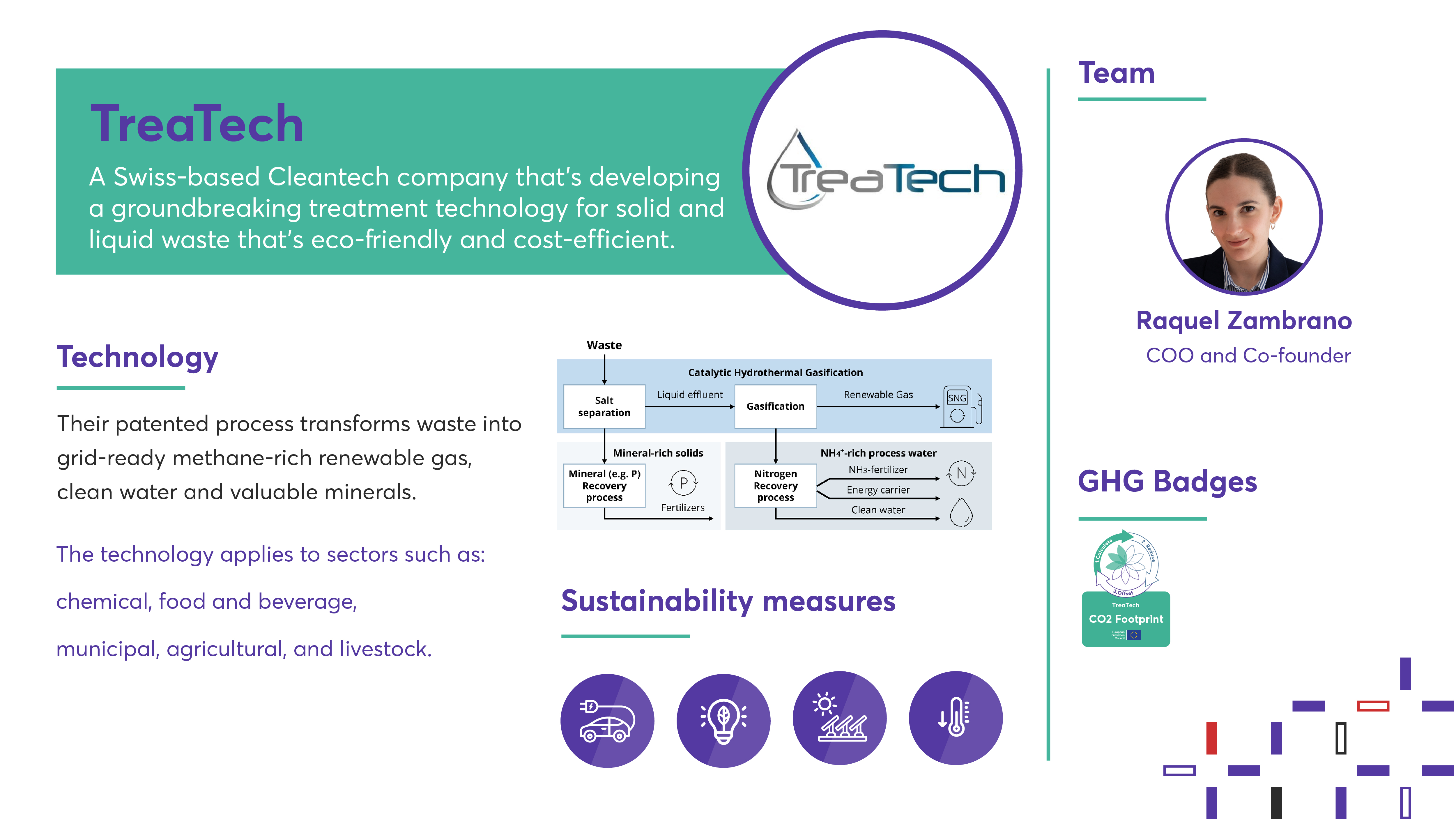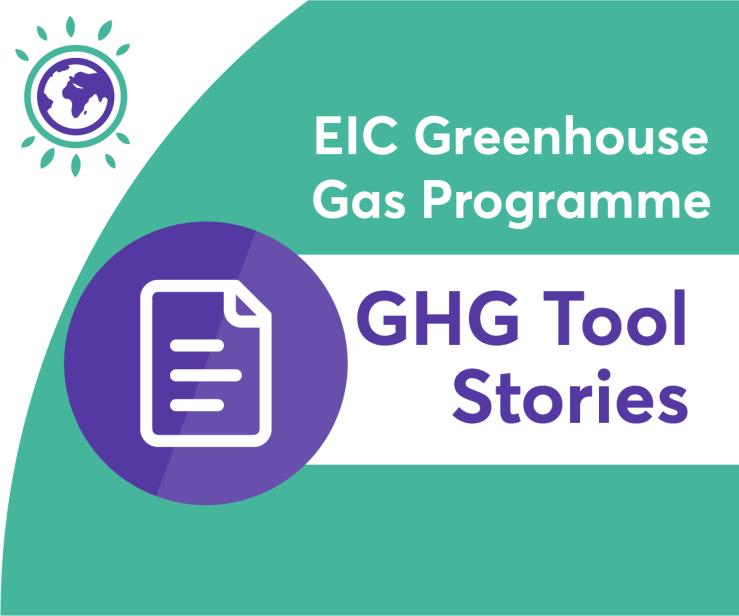The European Innovation Council (EIC), within the Greenhouse Gas Programme (GHG), has developed a dedicated GHG Tool to support beneficiaries in the assessment of their company’s carbon footprint. Given their core business, TreaTech, a Swiss-based Cleantech company founded in 2015 that’s developing a groundbreaking treatment technology for solid and liquid waste, joined the GHG Tool initiative. We met with Raquel Zambrano, COO and Co-founder, to discuss her participation and its current status.

Can you briefly describe your role in TreaTech?
I’m the Co-founder and COO at TreaTech. I coordinate different projects and oversee business development.
Could you describe your innovation and its positive contributions?
TreaTech is bringing to market an innovative technology that valorises solid and liquid waste. Our process transforms waste into methane-rich renewable gas, clean water, and minerals taking advantage of the properties of supercritical water. The robustness of our technology allows us to treat a wide range of wastes from various sectors such as chemical, food and beverage, municipal, agricultural, and livestock.
The technology has been successfully demonstrated at a pilot scale. We have built a pilot plant in collaboration with the Paul Scherrer Institute in the North of Switzerland, that can process 100 kg of waste per hour. Our next step is to install demo units at our customer's sites to test the technology in a real environment. We live in a time where local renewable gas is important not only for circular economy and sustainability but also for energy independence. Through our innovation, we can help with this, since TreaTech’s system produces local, contaminant-free gas that is grid ready.

Tell us how participating in the EIC GHG Programme has strategically helped your company so far.
Taking into consideration our core business, which is producing renewable energy from waste, it’s a must for us to become CO2 neutral. For that, participating in the EIC GHG Programme was of the utmost importance. Even though it’s a bit early to evaluate the global effect of our participation, I believe that soon we’ll be able to see the main impact of the reduction measures we selected and then do a proper evaluation.
Did the EIC GHG Tool help you increase your awareness of the amount of GHG emissions generated by your company? If yes, could you elaborate?
We passed the phase of calculating our footprint, so now we have a better notion of how much it takes to emit one tonne of CO2, for instance. Also, since we have research units related to our technology, the meetings we had with the GHG experts were quite helpful for us because we could see how much we emit and evaluate the carbon footprint of our product. Not only is it great to know our carbon footprint in terms of business, but it’s also important to have a sense of it when compared to a normal household, for example. Having this kind of comparison in mind is useful.
What is the status of your participation (regarding the Badges/CO2 Neutral Label/GHG Tool initiative)?
Initially, the first step was to calculate our carbon footprint and engage in the necessary steps to obtain the CO2 Footprint badge – which we did. Now, we are working to receive the CO2 Reduction badge, and the next step is to work toward the CO2 Neutral one.
Did the input received from the GHG experts contribute further towards the green transition journey?
Without a doubt. In the beginning, we weren’t sure how to calculate our footprint nor how to select the best measures for our company to help reduce our emissions. Having the help of the GHG experts made all the difference in understanding the measures and selecting the ones we intend to implement. Therefore, it was helpful.
What measures did you implement or wish to implement?
TreaTech is at its early stages. Given the business status of our company, we need to carefully select which ones are more useful to us based on our type of business. Following several discussions with the GHG experts, we could find a list of measures that we can implement and one of the key ones is (1) switching the on-site equipment to renewable resources.
Since we have few research facilities and our technology consists of producing renewables, it makes sense to use these renewables to fuel our installations. Other ones that we will be implementing are (2) eco-driving for company vehicles, (3) reducing the set point temperature for the heating in the offices and (4) optimising the energy regulation systems. Another one is disclosing our carbon footprint internally to raise awareness about it.
How did the measures you implemented affected positively your return on investment (economically, environmentally, socially, etc.)?
Doing your best to reduce your company’s carbon footprint is always positive. Of course, it mitigates the effects of global climate change, which is the main issue right now, but it also helps to improve public health and boost the global economy, as it impacts companies as well. The more sustainable you are, the fewer taxes you pay, and the better it is for the environment. It’s a win-win.
In my opinion, it’s also important to promote these types of green initiatives and activities to help raise awareness. That way, other companies and society can become more engaged. We might be a small company with a small carbon footprint, but if we all do our part it will be better for the future of our planet. Therefore, the sooner companies start doing their part, no matter their size, the better and easier it will be to be responsible throughout their growth.
What are the most interesting elements provided by the GHG tool compared to other similar tools?
We only tried the EIC’s GHG Tool. We joined the Tool initiative from the beginning, and it was interesting to see the GHG team gathering feedback from the participants to continuously improve it. As for the GHG Tool, we found it quite useful not only to calculate our footprint but also to do simulations of our company’s future and our plans for our technology.
Are there any other aspects you wish to highlight?
Being part of the EIC’s GHG Tool initiative was a useful and interesting journey. I found it interactive and ensured I took advantage of all the workshops that took place, asked pertinent questions, gave constructive feedback and soaked in important information regarding some topics that could be improved or weren’t yet clear to me.
Additional information
About TreaTech
TreaTech has developed a pioneering technology that transforms solid and liquid waste from a liability into a resource. The solution, based on catalytic hydrothermal gasification, converts a wide range of wastes from different industries (i.e., chemical, food and beverage, municipal, or livestock) into local, pollutant-free, and methane-rich renewable gas. It also recovers valuable finite minerals (i.e., phosphorus) as well as the water contained in the waste that is clean after the process. As countries are striving for energy independence, this type of technology could contribute by generating a sustainable supply of gas.
About the EIC Business Acceleration Services
This opportunity is brought to you by the EIC Business Acceleration Services. To explore other opportunities to connect with the largest corporates in Europe, keep an eye on our events page.
About the EIC GHG Programme
With the EIC GHG programme, part of the Business Acceleration Services, the EIC offers its beneficiaries a dedicated GHG tool, the GHG Badges & CO2 Neutral Label initiative, and further resources.
In addition, co-creation activities with corporates, industrial associations, regions in carbon transition and other EIC beneficiaries are taking place on a regular basis.


